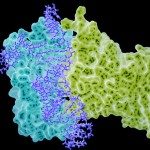Link to Pubmed [PMID] – 26291722
PLoS ONE 2015;10(8):e0135455
We present a 3D model of the four transmembrane (TM) helical regions of bilitranslocase (BTL), a structurally uncharacterized protein that transports organic anions across the cell membrane. The model was computed by considering helix-helix interactions as primary constraints, using Monte Carlo simulations. The interactions between the TM2 and TM3 segments have been confirmed by Förster resonance energy transfer (FRET) spectroscopy and nuclear magnetic resonance (NMR) spectroscopy, increasing our confidence in the model. Several insights into the BTL transport mechanism were obtained by analyzing the model. For example, the observed cis-trans Leu-Pro peptide bond isomerization in the TM3 fragment may indicate a key conformational change during anion transport by BTL. Our structural model of BTL may facilitate further studies, including drug discovery.

